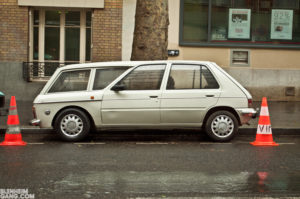Slate August, 8th 2012 > version française
THE APPEAL OF FRENCH CARS
…or rather, who better than the French to solve the problem with French cars.
Even though societies have gone global, the contemporary French automobile has not had the same history as its competitors nor does it enjoy the same advantages for cutting a quick exit out of the current global traffic jam.
In the mid-90’s, German car makers invested their efforts on the ‘perceived’ qualities of automobiles (emphasis on ‘perceived’ because today, the resistance and solidity of basic automobile functions on all cars produced everywhere–motor, gear-box, transmission, chassis–far exceed the demands made on these functions).
This was extremely complex and costly, akin to a 3-star restaurant serving up 30,000 incredibly sophisticated dishes every day. But, efforts have paid off with expanding sales worldwide, and ubiquitous craving from China to the U.S.A. to South America where the pervading belief is that VW is a Brasilian brand.
Meanwhile, French car makers have concentrated on optimising their industrial tool following the model used by he Japanese: ‘just-in-time’ production, extreme flexibility, massive and coercive sub-contracting . . . The latter have in turn profited by seducing the African market left aside by the French.
Ten years on, once the respective strategies were in place (and financial crises were easing), each manufacturer sought out the advantages of the others. The Germans streamlined production to reduce costs (interestingly, in 2004, production time for a VW Golf was three times that for a similar Toyota). This was easier to achieve for the Germans than the French who were aiming for a techno-centric German model, tweaking a car door to ‘clink’ rather than ‘clank’ when closing.
Volkswagen’s strategy has resulted in profit margins approaching 7% (Renault is slightly over 2% and PSA is losing money . . .) and daily earnings of €50 million. This may seem substantial but is less so in the context of Apple’s 30% commissions revenue approaching several million euros a day on iPod/iPhone/iPad applications developed by outside companies, or Google’s daily earnings of $42 million in 2011.
True, German cars are fantastic. On a rainy day, a commuter living 100 km from the office can get to work in 20 minutes while listening to opera in nearly perfect acoustic conditions. But in 2012, with economic, social and ecological crises consuming headlines, can it still be argued that the future of the automobile belongs to top-of-the-line, 400 HP sedans with 4-wheel drive? If we think hard, surely we can find alternative ways of looking at the problem.
Despite the earning power of the technically supreme German model, we’re beginning to see signs of obesity (dual clutch and 9 speed transmissions . . .), decadent styling (taillights lit up like Xmas trees, stretch marks on the body . . .) signaling a much-needed mutation of these obsolescent dinosaurs. In the near term, even the Germans will be obligated to change their current working model.

France is reputed for its freedom of spirit, its creativity in materializing dreams and creating narratives in the realms of luxury, tourism, culture; for revolutionizing obsolete and inequitable systems; for placing humanity at the center of preoccupations to get to the very substance of cultures and disciplines.
What if such lamented habits as rejecting preconceived notions, intellectualizing debate, engaging in critique, became opportunities for changing our viewpoint on an industry rich in savoir-faire and full of potential?
Today, with fuel as hard to come by as cash, perhaps we should consider taking the automobile-as-object off its pedestal and looking at its use potential to enhance the experience of users.
A healthy dose of insubordination regarding mass-market automobiles, epitomized by the FREE CAR PROJECT, applicable to other market segments as well, would allow us to envision revenues commensurate with those we see in the New Economy of digital technology. Putting aside the intimidation factor of German references, the French can promulgate a new vision to reinvigorate high-end models “à la française” (obviously, we’re not talking about the subtlety of pearl-finished door handles or the number of blades on custom rabbit rims).

Why don’t French car makers glamorize people instead of just their cars?
A relevant economic model is not a €100,000 vehicle loaded down with €85,000 worth of industrial-strength stuff (profit margins are greater on high-end cars), but rather, for the same price, to offer a graceful and lightweight electric roadster accompanied by substantial investment in ‘green’ energy production.
A potential buyer of this car would enjoy a two-fold advantage: first, benefitting from a quality profile among passing admirers (it’s more chic to seen as promoting wind turbine energy than to get spit on at the stop light inside a ‘made-in-Germany’ 4×4); second, securing an investment that collectively profits all while personally accruing savings. And, the icing on the cake is that the buyer can at last drive a ‘finely-tuned’ and refined vehicle alleviated from the indigestion brought on by brand-name cars. Luxury can also be manifested by a sense of well-being.
This strategy would allow French manufacturers to redefine their approach to this market segment with a unique and pertinent offering requiring limited investment.
http://blog.slate.fr/free-car-project/2012/08/14/les-atouts-de-lautomobile-francaise/
08/14/2012